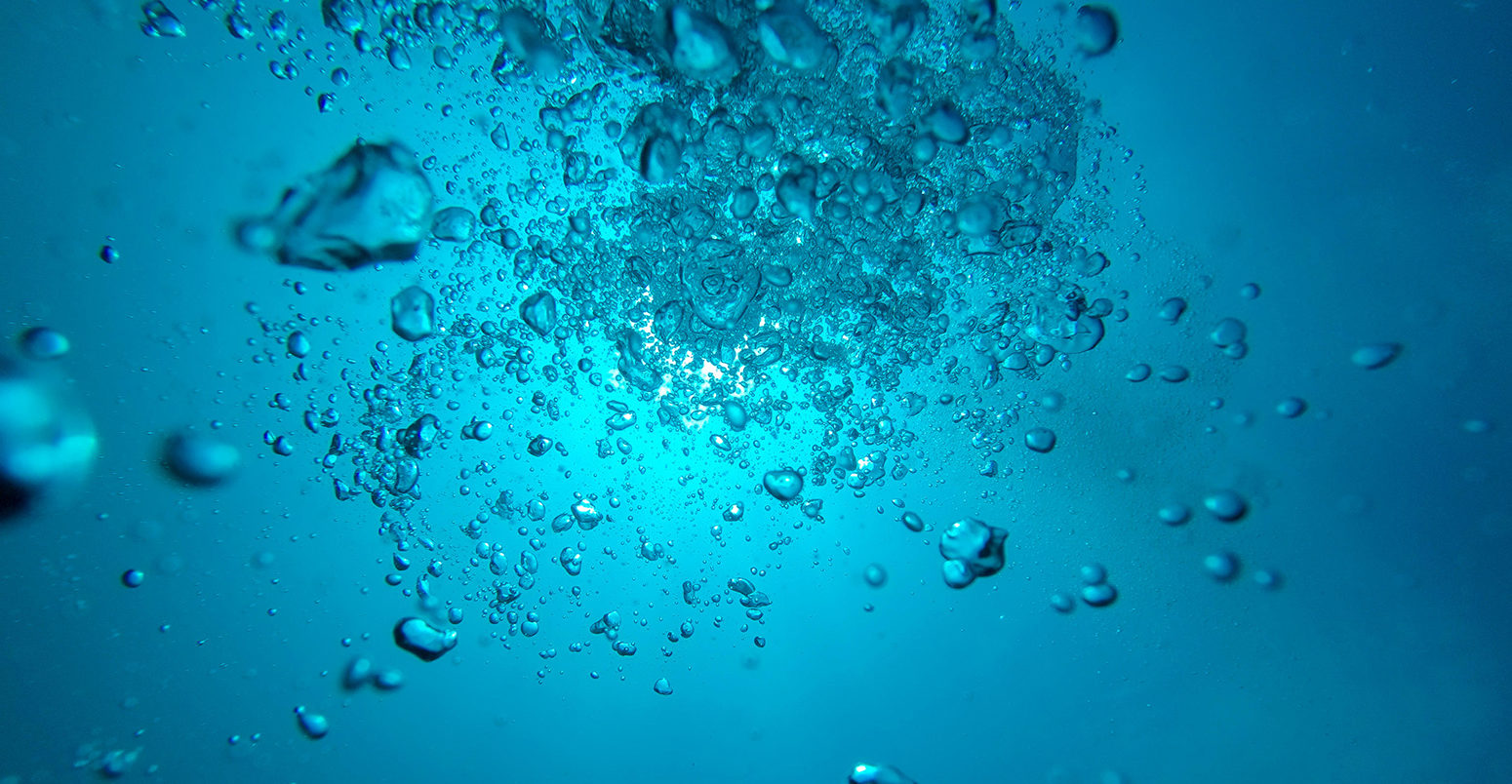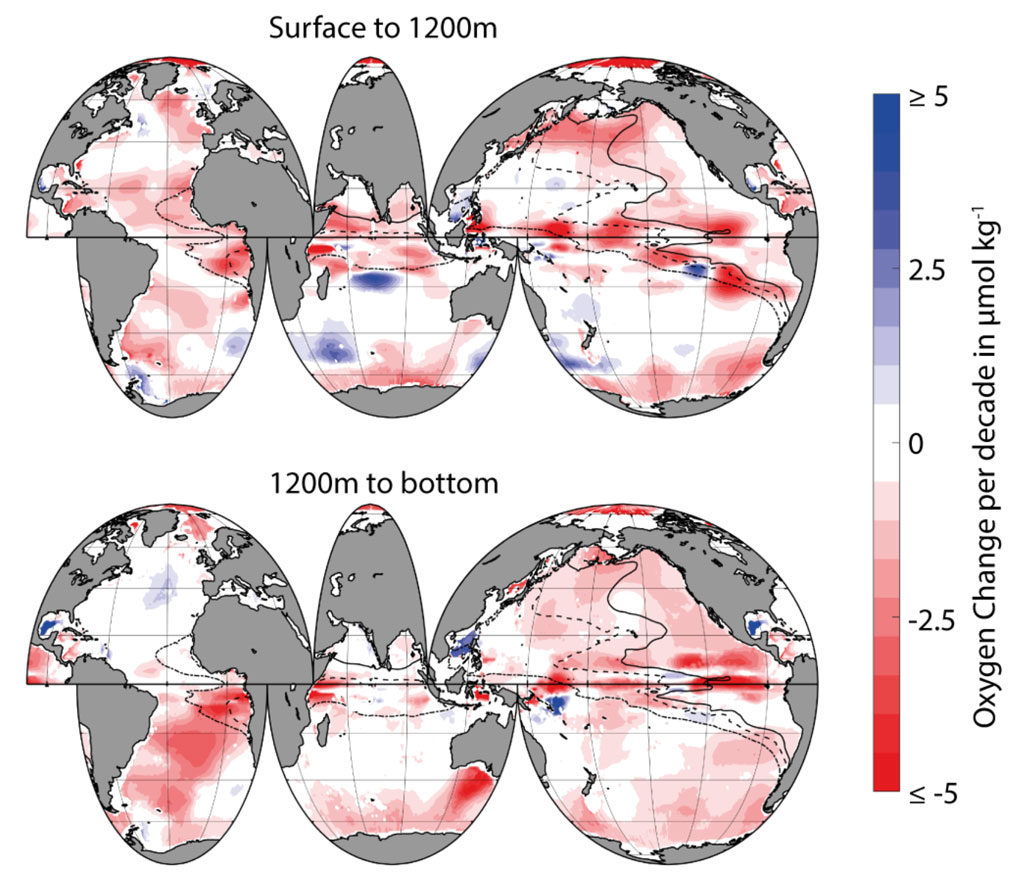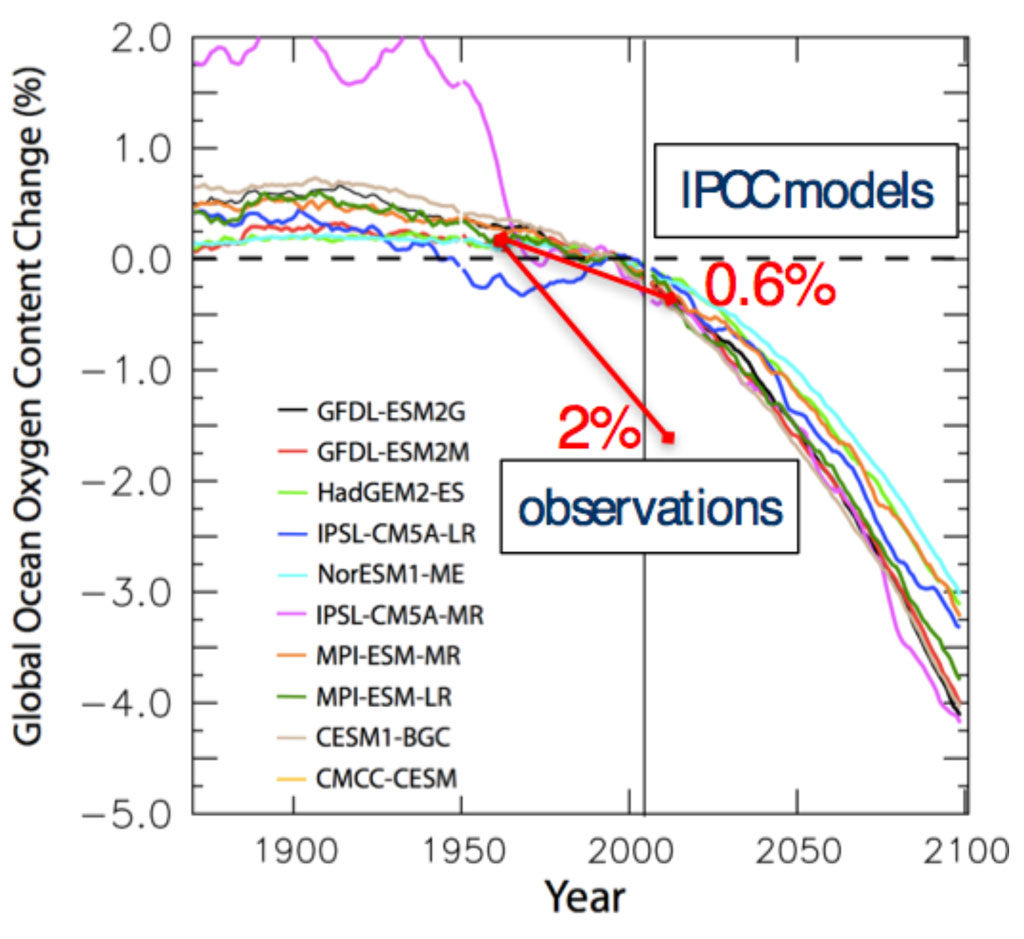
Guest post: How global warming is causing ocean oxygen levels to fall
Multiple Authors
06.15.18Prof Andreas Oschlies is head of the marine biogeochemical modelling group and speaker of the Collaborative Research Centre SFB 754 at the Helmholtz Centre for Ocean Research Kiel (GEOMAR) and Kiel University, Prof Peter Brandt is professor of physical oceanography at GEOMAR and Kiel University, and Dr Lothar Stramma and Dr Sunke Schmidtko are senior scientists in the physical oceanography group at GEOMAR.
Direct measurements show the amount of oxygen in the global oceans has decreased by around 2% over the past 50 years.
Climate change is thought to be a principal cause of this “deoxygenation”, affecting how much oxygen seawater can hold and the circulation patterns that carry oxygen-rich water to the deeper ocean.
In a new review paper, published in Nature Geoscience, we assess the scientific literature on the direct and indirect impacts of rising global temperatures on ocean oxygen levels, and the threat this poses to marine life.
Our findings show that climate models underestimate deoxygenation to date, but project that it will continue and accelerate. Improving understanding on the processes involved and expanding data collection will help reduce the uncertainties in models and, hence, produce more robust projections.
Dangers of deoxygenation
At the ocean surface, oxygen is supplied through air-sea gas exchange and from photosynthesising marine plants. For the rest of the oceans, the distribution of oxygen is, therefore, governed by a delicate balance of supply from the surface via circulation and mixing and consumption by marine life through respiration.
Across the global oceans today, there are various pockets with low or no oxygen – including parts of the tropical oceans off California, Peru and Namibia and the subsurface waters of the Arabian Sea.
“Oxygen minimum zones” are a natural phenomenon, caused by the combined action of sluggish ocean circulation and the decomposition of organic matter sinking out of productive surface areas often associated with ocean upwelling regions.
The oxygen levels in these zones are low enough to be lethal to most marine life. Low oxygen regions can also release nitrous oxide (N2O) – a potent greenhouse gas – into the atmosphere.
Research suggests that these low-oxygen regions are expanding, which could have “dramatic” biological, ecological, economic and climatic consequences.
And the risk of deoxygenation is not just limited to these specific zones. Reducing oxygen levels is occurring at all oxygen concentrations in all ocean basins and affects a growing number of coastal regions.
Role of global warming
While the oxygen dissolved in seawater only amounts to around 0.6% of what the atmosphere contains, it is nevertheless essential for all higher forms of marine life. In addition, the respiration of organisms continuously consumes oxygen essentially everywhere in the ocean.
The most recent and comprehensive analysis of oxygen changes in the global oceans suggests there has been an average 2% decline since 1960.
As the maps below indicate, deoxygenation varies considerably across the oceans. They show gains (blue shading) and losses (red) in oxygen in the ocean down to 1,200 metres (upper map) and beyond (lower). The largest declines in oxygen have predominantly occurred along the equator and in the Arctic.

Oxygen change in the ocean. Observational estimate of the 50yr (1960 to 2010) oxygen change in the upper (0-1,200m) and deep (1,200m – sea floor) ocean in micromole per kilogram per decade (µmol/kg/decade). Data are taken from Schmidtko et al. (2017). Lines indicate boundaries of oxygen minimum zones with less than 80 µmol/kg of oxygen anywhere within the water column (dash-dotted), less than 40 µmol/kg (dashed) and less than 20 µmol/kg (solid). Modified from: Oschlies, et al. (2018)
Research shows that human-caused global warming is the principal cause of marine oxygen loss. Humans also play an additional role through the input of nutrients to the oceans in coastal regions, though the individual processes at play are not straightforward to disentangle.
Warming affects the ocean and its dissolved oxygen content in several ways. Among other things, it influences the solubility of oxygen in the water. The warmer the water, the less gas that can dissolve in it.
Until now, this process mainly affected the upper few hundred meters of the oceans, which have been in contact with the atmosphere most recently. This effect explains up to 20% of the total marine oxygen loss so far and about 50% of that in the upper 1,000 metres of the oceans.
In addition, warming alters patterns of global ocean circulation, which affects the mixing of oxygen-rich surface waters with deeper oxygen-poor water. It also changes how quickly organisms metabolise and respire, which affects consumption of marine oxygen.
Finally, there are indirect impacts of warming on upper-ocean nutrient supply and subsequent production and downward export of organic matter available for respiration throughout the ocean.
Models
In general, climate model simulations underestimate the scale of the observed deoxygenation. As the chart below shows, the global models used in the fifth assessment report of the Intergovernmental Panel on Climate Change (IPCC) on average simulate only one third of the 2% decline.
This discrepancy between observational estimates and models needs to be resolved to ensure reliable model projections of deoxygenation into the future.

Simulated evolution of the models of the fifth assessment report of the IPCC with an average 0.6% decline during the 50-year period 1960-2010 (after Bopp et al., 2013). The observational estimate for the period by Schmidtko et al. (2017) amounts to 2%.
While the decreased solubility of oxygen in warming seawater is generally well represented in models, improvements are needed to better capture the other impacts of rising temperatures.
For example, a surprising result of our analysis is the large estimated oxygen loss in regions of the deep ocean below 1200 metres in depth, particularly in the Southern Ocean, the Arctic and the tropical Pacific.
Yet models do generally not reproduce these deep-ocean oxygen changes. Resolving these limitations requires a better understanding of the physical processes involved, which – in turn – means expanding the coverage of direct measurements.
Biogeochemical feedbacks that can lead to accelerated oxygen loss, such as the release of phosphorus and iron from sediments beneath oxygen-free waters, are also not accounted for in most models today and may explain part of why they underestimate the deoxygenation to date.
Finally, improvements are needed to help models describe the complex system of surface and deep currents that supplies oxygen to the deeper ocean.
Ocean observation
Ocean oxygen loss is increasingly being recognised as a major threat to marine ecosystems and shifting habitat conditions in many parts of the global ocean.
Deoxygenation feedbacks on climate via the production of potent greenhouse gases such as N2O and methane under low-oxygen conditions become more likely in a warmer climate. Therefore, it is essential to resolve the discrepancy between observations and models, which are ultimately required for reliable projections into the future.
To close these gaps, we recommend more intensive and internationally-coordinated ocean observations. We need multidisciplinary process studies to better understand the delicate balance of oxygenation and oxygen consumption in the dynamically changing oceans.
Research projects like our Kiel-based Collaborative Research Centre SFB 754 Climate-Biogeochemistry Interactions in the Tropical Ocean and international initiatives such as the Global Ocean Oxygen Network are helpful in moving the field forward.
An improvement of the models in terms of the ocean oxygen budget would have another advantage: oxygen is an ideal parameter for calibrating models that calculate the uptake of CO2 by the ocean. Thus, at the same time, we would improve our knowledge of the carbon cycle.
Oschlies, A. et al. (2018) Drivers and mechanisms of ocean deoxygenation, Nature Geoscience, doi:10.1038/s41561-018-0152-2
Up-to-date information about research on ocean deoxygenation can be found at http://www.ocean-oxygen.org/.
-
Guest post: How global warming is causing ocean oxygen levels to fall
-
Oxygen levels in the global oceans have dropped 2% in 50 years – and climate change is the main cause

